“Veiled Meanings” at the Jewish Museum
November 2, 2017
Veiled Meanings: Fashioning Jewish Dress at the Jewish Museum (NYC) is the first ever comprehensive US exhibition of Jewish dress, drawn from The Israel Museum’s (Derech Ruppin, Jerusalem, Israel) renowned collection. The exhibition opens Friday, November 3rd and features over 100 articles of clothing ranging from the 18th to 20th centuries. Displayed either as complete ensembles or shown as stand-alone items, Veiled Meanings offers an exceptional opportunity for museum visitors to view these rarely seen garments and in the process, learn about different facets of fashion, culture, and identity.
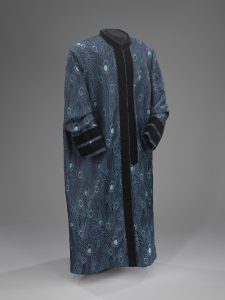
Hasidic Rebbes Sabbath Coat, Jerusalem, contemporary. Silk and synthetic thread, appliqué synthetic velvet bands; belt: compound weave. Photo: Mauro Magliani.
The Jewish Museum’s presentation focuses on how clothes balance personal and social lives, and how dress traditions distinguish different Jewish communities—showcasing the many facets of Jewish identity and culture. With an extraordinary range of textile and garment designs, Veiled Meanings illuminates how diverse global Jewish cultures have thrived, interacted, and inspired each other for centuries. The exhibition is organized into 4 thematic sections based on historical, geographic, social, and symbolic interpretation:
1) Through the Veil
Focuses on veils and wraps worn by Jewish women in Central Asia, revealing the influence of local Islamic culture on Jewish dress. Conversely, wraps worn by Jewish women inspired the adoption of new traditions; for example, the chader worn in Mashhad, Iran, was brought by Jews to Afghanistan.
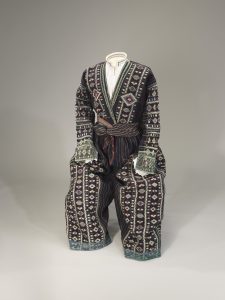
Groom’s outfit with amuletic symbols Zakho, Iraqi Kurdistan, early 20th century. Goat hair, brocaded weave, floss silk embroidery; shirt: cotton; sash: artificial silk. Photo: Mauro Magliani.
2) Interweaving Cultures
Broadly examines the migration of Jewish communities and the effects of acculturation. This section uncovers multicultural influences on motifs, styles, and dress-making techniques, as well as changes brought about by modernization. The ensembles displayed trace the melding of global dress customs and illustrate how clothing from distant locations and cultures influenced Jewish fashion, frequently resulting in innovative and often eclectic creations.
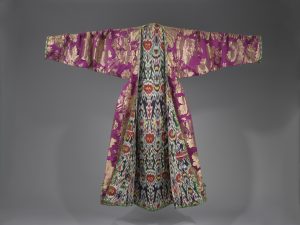
Kalltshak Lorna Woman’s Coat with a richly decorated lining, Bukhara, Uzbekistan, late 19th century. Brocaded silk, lining: silk and cotton, ikat-dyed. Photo: Mauro Magliani.
3) Exposing the Unseen
Magnifies the fine and often hidden details of clothing, the many layers and extraordinary craftsmanship that comprise an ensemble, and the symbolic embellishments that define a garment’s purpose. Also examined is the tension between the desire to reveal and the dictum to conceal—evident in aprons and bodices worn by women to cover specific areas of the body. Paradoxically, these often elaborately crafted modesty garments drew attention to the physical attributes they were intended to obscure.
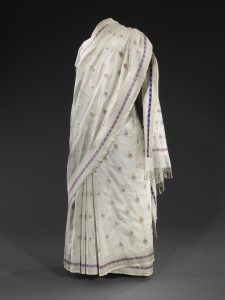
Wedding Sari Bene Israel Community, India, mid-20th century. Brocaded silk, silver and silk thread. Photo: Mauro Magliani.
4) Clothing that Remembers
Garments often serve to perpetuate the memory of the dead—at times after being repurposed or redesigned to fulfill this new role—as in the transformation of lavishly embroidered Ottoman Empire bridal dresses into commemorative Torah ark curtains.
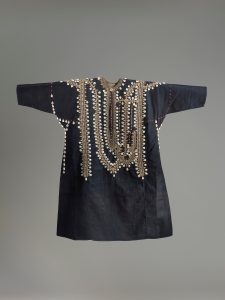
Boy’s or Girl’s Amuletic Dress, Sana‛a, Yemen, 1930s. Cotton, indigo dyed, cotton thread embroidery, kauri shells. Photo: Mauro Magliani.
Veiled Meanings highlights Jewish communities from Afghanistan, Algeria, Denmark, Egypt, Ethiopia, Germany, Georgia, Greece, India, Iran, Iraq, Iraqi Kurdistan, Israel, Italy, Libya, Morocco, Poland, Romania, Tunisia, Turkey, the United States, Uzbekistan, and Yemen, showcasing the color, texture, function, artistry, craftsmanship, and connections that can be made between these exquisite garments from the past and fashion, textile, and decorative design of today.
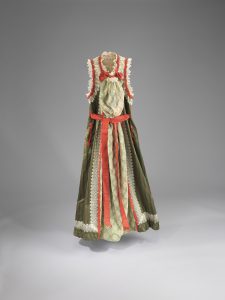
Womans ensemble, Tlemcen, Algeria, early twentieth century. Silk satin dress with cotton lace and silk ribbons; tulle blouse with silk-thread embroidery. Photo: Mauro Magliani.
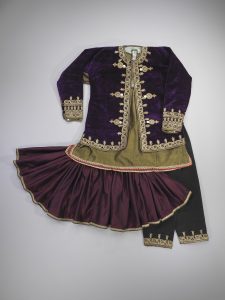
Womans attire, Mashhad, Iran, early twentieth century. Silk, silk velvet, cotton satin, and gilt-metal cord embroidery. The Israel Museum, Jerusalem. Photo: Mauro Magliani.
Details:
On display: November 3, 2017 through March 18, 2018.
Location: The Jewish Museum (1109 Fifth Avenue at 92nd Street, New York City)
Phone: 212.423.3200
Website: thejewishmuseum.org

1 Comment
judy anderson says
November 6, 2017 at 3:58 pm
Thanks for sharing
Related Blog Articles
No related blog articles yet.